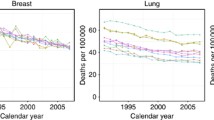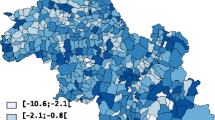Patterns of cancer incidence within five population density quintiles in New York State, exclusive of New York City, were investigated between 1978 and 1982. Sex-specific, standardized incidence ratios were calculated within each population density quintile for all cancer cases combined and for site-specific cancers based on cancer incidence patterns exhibited by the general population of New York State, exclusive of New York City. Areas with the highest population density demonstrated a 13 percent excess of cancer cases among males and a seven percent excess among females. In contrast, areas with the lowest population density exhibited lower cancer incidence, among both males (12 percent less) and females (12 percent less). Males demonstrated a significant, direct linear relationship between increasing population density and all cancer sites combined, and for cancers of the oral cavity and pharynx, esophagus, stomach, colon, rectum, liver, pancreas, larynx, lung, bladder, brain, and nervous system, and for Hodgkin's disease and multiple myelomas. Among females, a significant, direct linear relationship was observed between increasing population density and all cancer sites combined, and for cancers of the buccal cavity and pharynx, esophagus, stomach, lung, breast, and kidney. Malignant melanomas of the skin, and in situ and invasive cancers of the cervix exhibited unusual incidence patterns across the population density quintiles. These data are most useful in generating hypotheses for further studies to define specific etiologic factors operating within population density groupings. Population density, as measured in this investigation, may represent a surrogate measure for other factors which are related to cancer morbidity.
Similar content being viewed by others
References
Griswold MH, Wilder CS, Cutler SJ, et al. Cancer in Connecticut, 1935–1951. Hartford, CT: Connecticut State Department of Health, 1955: 97–101.
Clemmesen J, Nielsen A. Comparison of age-adjusted cancer incidence rates in Denmark and the United States. JNCI 1957; 19: 989–98.
Saxen E, Korpela A. Cancer incidence in Finland, 1954. Ann Chir Gynaecol Fenn 1958; 47 (Suppl. 79): 1–32.
Pedersen E, Magnus K. Cancer Registration in Norway. The Incidence of Cancer in Norway, 1953–1954. Oslo, Norway: Norwegian Cancer Society, 1959; The Cancer Registry of Norway, Monogr No. 1: 44–157.
Levin ML, Haenszel W, Carroll BE, et al. Cancer incidence in urban and rural areas of New York State. JNCI 1960; 24: 1243–57.
Teppo L, Hakama M, Hakulinen T, et al. Cancer in Finland 1953–1970: incidence, mortality, prevalence. Acta Pathol Microbiol Scand (A) Suppl. 1975; 252: 13.
Haenszel W, Marcus SE, Zimmerer EG. Cancer morbidity in urban and rural Iowa. Washington, DC: US Government Printing Office 1956; Public Health Monogr No. 37; Public Health Series Pub. No. 462: 1–85.
Finger-Kantor AL, Meigs JW, Heston JF, et al. Epidemiology of renal cell carcinoma in Connecticut, 1935–1973. JNCI 1976; 57: 495–500.
Baquet CR, Horm JW, Gibbs T, et al. Socioeconomic factors and cancer incidence among Blacks and Whites. JNCI 1991; 83: 551–7.
Nasca PC, Burnett WS, Greenwald P, et al. Population density as an indicator of urban-rural differences in cancer incidence, Upstate New York, 1968–1972. Am J Epidemiol 1980; 112: 362–75.
Mahoney MC, LaBrie DS, Nasca PC, et al. Population density and cancer mortality differences in New York State, 1978–1982. Int J Epidemiol 1990; 19: 483–90.
United States Bureau of the Census. General Population Characteristics, New York. Washington, DC: US Government Printing Office, 1982.
Special Report on Municipal Affairs for Local Fiscal Years Ended in 1981. Albany, NY: Division of Municipal Affairs, Office of the State Comptroller, 1982; Legislative Document No. 92.
World Health Organization. Manual of the International Statistical Classification of Diseases, Injuries and Causes of Death, Eighth Revision. Geneva, Switzerland: WHO, 1968.
World Health Organization. Manual of the International Statistical Classification of Diseases, Injuries and Causes of Death, Ninth Revision, Geneva, Switzerland: WHO, 1977.
Haenszel W, Loveland DB, Sirken MG. Lung cancer mortality as related to residence and smoking histories I. White males. JNCI 1962; 23: 947–1001; Mantel N, Appendix C.
Bailar J and Ederer F. Significance factors for the ratio of a Poisson variable to its expectation. Biometrics 1964; 20: 639–43.
Armitage P. Statistical Methods in Medical Research. New York: John Wiley and Sons, 1971: 159–63.
Hedrick JL. Smoking, Tobacco and Health. Washington, DC: USDHEW, 1969; National Clearing House for Smoking and Health Pub. No. 1931.
Unpublished data. Rockville MD: Office on Smoking and Health, Centers for Disease Control, 1991.
Stark AD, Chang H, Fitzgerald EF, et al. A retrospective cohort study of mortality among New York State farm bureau members. Arch Environ Hlth 1987; 42: 204–12.
Author information
Authors and Affiliations
Additional information
Authors are with the Bureau of Cancer Epidemiology, New York State Department of Health. Drs Nasca and Maboney are also with the Department of Epidemiology, School of Public Health State, University of New York at Albany. Address correspondence to Dr Nasca at the Bureau of Cancer Epidemiology, Tower 565, New York State Department of Health, Albany, NY 12237-0683, USA.
Rights and permissions
About this article
Cite this article
Nasca, P.C., Mahoney, M.C. & Wolfgang, P.E. Population density and cancer incidence differentials in New York State, 1978–82. Cancer Causes Control 3, 7–15 (1992). https://doi.org/10.1007/BF00051906
Received:
Accepted:
Issue Date:
DOI: https://doi.org/10.1007/BF00051906




